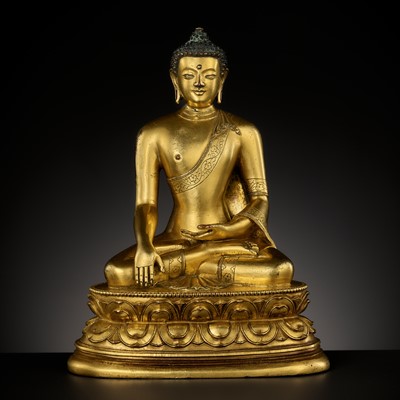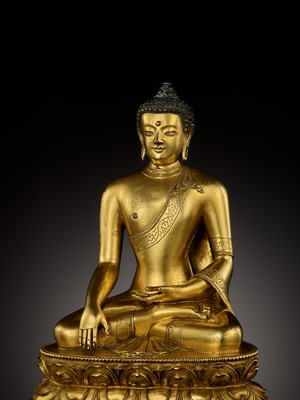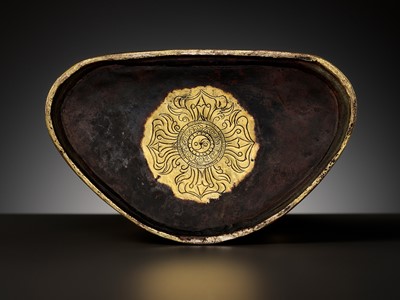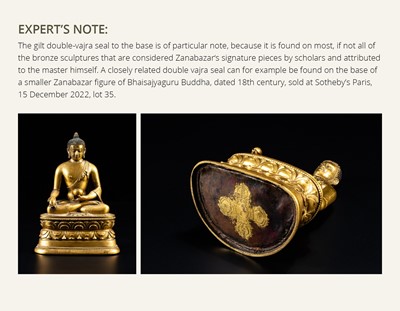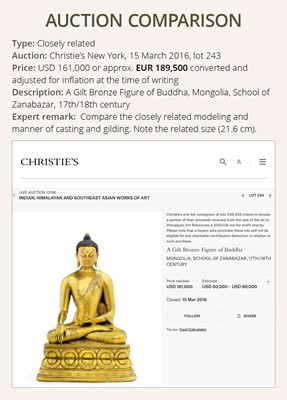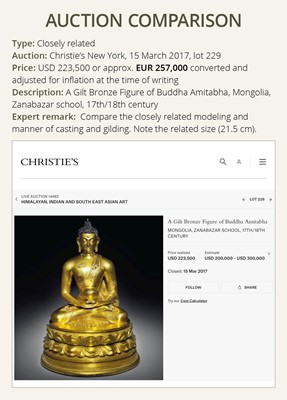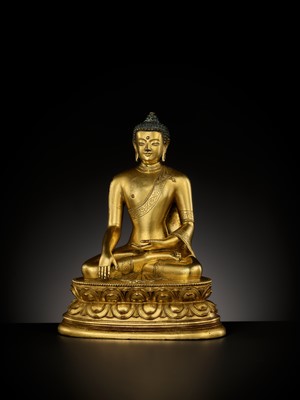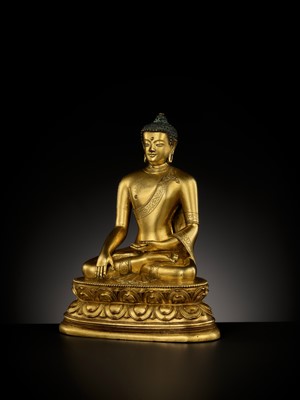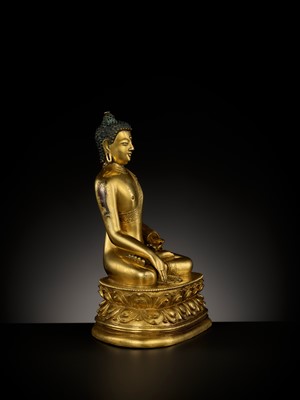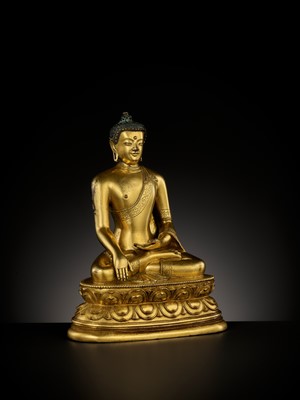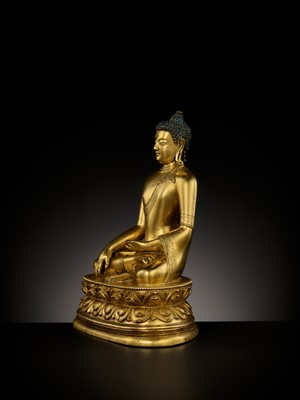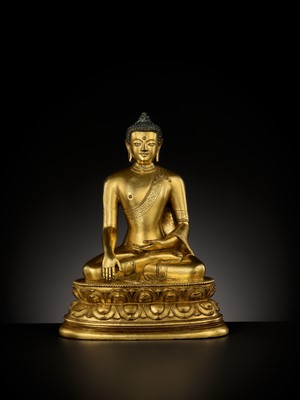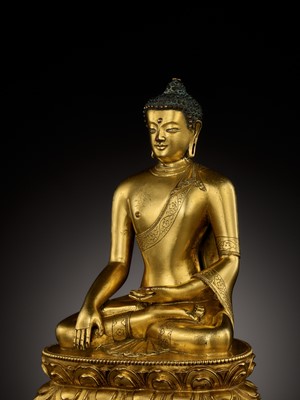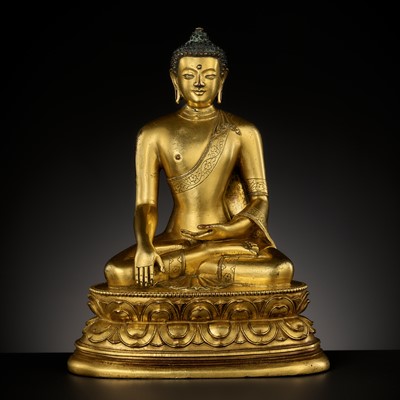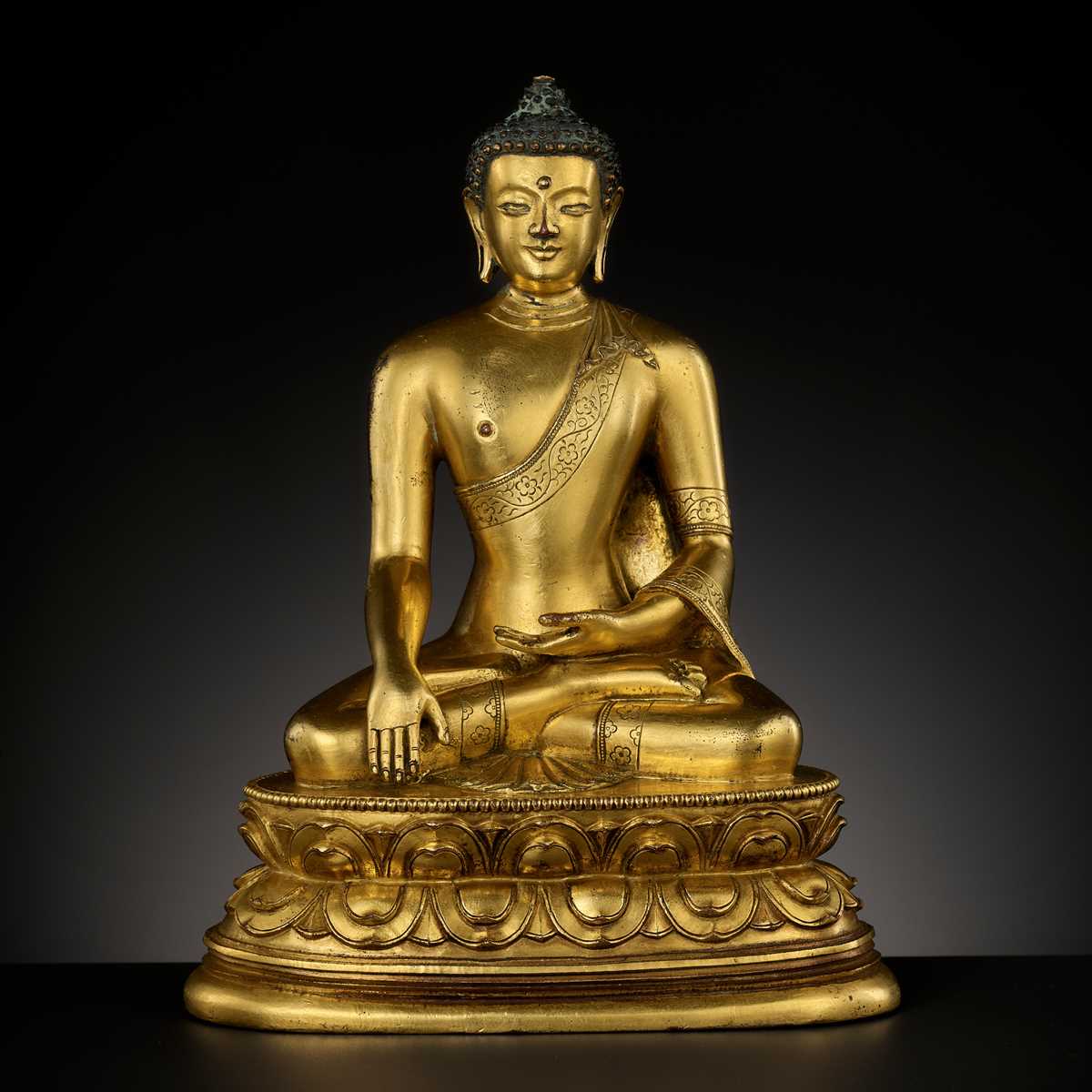11th Apr, 2024 11:00
TWO-DAY AUCTION: Fine Asian Art, Buddhism and Hinduism
35
A RARE AND IMPORTANT GILT-BRONZE FIGURE OF BUDDHA, ZANABAZAR SCHOOL
Sold for €18,200
including Buyer's Premium
Expert’s note: The gilt double-vajra seal to the base is of particular note, because it is found on most, if not all of the bronze sculptures that are considered Zanabazar's signature pieces by scholars and attributed to the master himself. A closely related double vajra seal can for example be found on the base of a smaller Zanabazar figure of Bhaisajyaguru Buddha, dated 18th century, sold at Sotheby’s Paris, 15 December 2022, lot 35.
Mongolia, 17th-18th century. Seated in dhyanasana on a double lotus base with crisply cast beaded rim, his right hand lowered in bhumisparsha mudra and the left resting in his lap, clad in a closely-fitting sanghati with a patterned hem, the folds elegantly draped over the right shoulder and fanning below the ankles. The serene face sensitively modeled depicting downcast eyes with sinuous lids below gently arched brows centered by a raised urna, an aquiline nose above bow-shaped lips, and the hair in fine tight curls over the prominent ushnisha and topped with a gold knop. The seal plate with a gilt and incised double-vajra seal.
Provenance: From a Dutch private collection.
Condition: Good condition with minor casting irregularities including casting fissures, little wear to the gilt, tiny nicks, light surface scratches, few small dents, the alms bowl lost.
Weight: 2.5 kg
Dimensions: Height 20.7 cm
This heavily cast and finely gilt bronze belongs to the Zanabazar artistic school of Mongolia, founded in the 17th century by Jetsun Lobzong Tenpai Gyaltsen (1635-1723). He was an important Mongolian religious figure and personal guru to the Kangxi Emperor. Zanabazar was at an early age recognized by both the Panchen Lama and Dalai Lama as the reincarnation of the Tibetan Lama, Taranatha (1575-1634), and proclaimed the First Jetsundamba, an honorific title. He traveled to Tibet to continue his religious instruction before returning to Mongolia in 1651, bringing fifty sculptors and painters with him in an attempt to establish the Geluk order amongst the Mongols.
During his time as a religious leader of the Khalkha Mongols, Zanabazar oversaw a proliferation of Buddhist art in the region. He is especially known for his visualization and design of gilt-bronze sculpture, subsequently carried out by Nepalese bronze casters, which are widely recognized as some of the finest Buddhist gilt-bronze sculptures created.
Zanabazar bronze sculptures exhibit a cohesive style testament to the vision of the great leader, characterized by richly gilt surfaces overall, finely modeled and smoothly sloping contours with embellishments limited to borders, full figures standing or seated on an elevated double-lotus base, and a minimalist aesthetic that endows the figures with a sense of stability.
Auction result comparison:
Type: Closely related
Auction: Christie’s New York, 15 March 2016, lot 243
Price: USD 161,000 or approx. EUR 189,500 converted and adjusted for inflation at the time of writing
Description: A Gilt Bronze Figure of Buddha, Mongolia, School of Zanabazar, 17th/18th century
Expert remark: Compare the closely related modeling and manner of casting and gilding. Note the related size (21.6 cm).
Auction result comparison:
Type: Closely related
Auction: Christie’s New York, 15 March 2017, lot 229
Price: USD 223,500 or approx. EUR 257,000 converted and adjusted for inflation at the time of writing
Description: A Gilt Bronze Figure of Buddha Amitabha, Mongolia, Zanabazar school, 17th/18th century
Expert remark: Compare the closely related modeling and manner of casting and gilding. Note the related size (21.5 cm).
Expert’s note: The gilt double-vajra seal to the base is of particular note, because it is found on most, if not all of the bronze sculptures that are considered Zanabazar's signature pieces by scholars and attributed to the master himself. A closely related double vajra seal can for example be found on the base of a smaller Zanabazar figure of Bhaisajyaguru Buddha, dated 18th century, sold at Sotheby’s Paris, 15 December 2022, lot 35.
Mongolia, 17th-18th century. Seated in dhyanasana on a double lotus base with crisply cast beaded rim, his right hand lowered in bhumisparsha mudra and the left resting in his lap, clad in a closely-fitting sanghati with a patterned hem, the folds elegantly draped over the right shoulder and fanning below the ankles. The serene face sensitively modeled depicting downcast eyes with sinuous lids below gently arched brows centered by a raised urna, an aquiline nose above bow-shaped lips, and the hair in fine tight curls over the prominent ushnisha and topped with a gold knop. The seal plate with a gilt and incised double-vajra seal.
Provenance: From a Dutch private collection.
Condition: Good condition with minor casting irregularities including casting fissures, little wear to the gilt, tiny nicks, light surface scratches, few small dents, the alms bowl lost.
Weight: 2.5 kg
Dimensions: Height 20.7 cm
This heavily cast and finely gilt bronze belongs to the Zanabazar artistic school of Mongolia, founded in the 17th century by Jetsun Lobzong Tenpai Gyaltsen (1635-1723). He was an important Mongolian religious figure and personal guru to the Kangxi Emperor. Zanabazar was at an early age recognized by both the Panchen Lama and Dalai Lama as the reincarnation of the Tibetan Lama, Taranatha (1575-1634), and proclaimed the First Jetsundamba, an honorific title. He traveled to Tibet to continue his religious instruction before returning to Mongolia in 1651, bringing fifty sculptors and painters with him in an attempt to establish the Geluk order amongst the Mongols.
During his time as a religious leader of the Khalkha Mongols, Zanabazar oversaw a proliferation of Buddhist art in the region. He is especially known for his visualization and design of gilt-bronze sculpture, subsequently carried out by Nepalese bronze casters, which are widely recognized as some of the finest Buddhist gilt-bronze sculptures created.
Zanabazar bronze sculptures exhibit a cohesive style testament to the vision of the great leader, characterized by richly gilt surfaces overall, finely modeled and smoothly sloping contours with embellishments limited to borders, full figures standing or seated on an elevated double-lotus base, and a minimalist aesthetic that endows the figures with a sense of stability.
Auction result comparison:
Type: Closely related
Auction: Christie’s New York, 15 March 2016, lot 243
Price: USD 161,000 or approx. EUR 189,500 converted and adjusted for inflation at the time of writing
Description: A Gilt Bronze Figure of Buddha, Mongolia, School of Zanabazar, 17th/18th century
Expert remark: Compare the closely related modeling and manner of casting and gilding. Note the related size (21.6 cm).
Auction result comparison:
Type: Closely related
Auction: Christie’s New York, 15 March 2017, lot 229
Price: USD 223,500 or approx. EUR 257,000 converted and adjusted for inflation at the time of writing
Description: A Gilt Bronze Figure of Buddha Amitabha, Mongolia, Zanabazar school, 17th/18th century
Expert remark: Compare the closely related modeling and manner of casting and gilding. Note the related size (21.5 cm).
Zacke Live Online Bidding
Our online bidding platform makes it easier than ever to bid in our auctions! When you bid through our website, you can take advantage of our premium buyer's terms without incurring any additional online bidding surcharges.
To bid live online, you'll need to create an online account. Once your account is created and your identity is verified, you can register to bid in an auction up to 12 hours before the auction begins.
Intended Spend and Bid Limits
When you register to bid in an online auction, you will need to share your intended maximum spending budget for the auction. We will then review your intended spend and set a bid limit for you. Once you have pre-registered for a live online auction, you can see your intended spend and bid limit by going to 'Account Settings' and clicking on 'Live Bidding Registrations'.
Your bid limit will be the maximum amount you can bid during the auction. Your bid limit is for the hammer price and is not affected by the buyer’s premium and VAT. For example, if you have a bid limit of €1,000 and place two winning bids for €300 and €200, then you will only be able to bid €500 for the rest of the auction. If you try to place a bid that is higher than €500, you will not be able to do so.
Online Absentee and Telephone Bids
You can now leave absentee and telephone bids on our website!
Absentee Bidding
Once you've created an account and your identity is verified, you can leave your absentee bid directly on the lot page. We will contact you when your bids have been confirmed.
Telephone Bidding
Once you've created an account and your identity is verified, you can leave telephone bids online. We will contact you when your bids have been confirmed.
Classic Absentee and Telephone Bidding Form
You can still submit absentee and telephone bids by email or fax if you prefer. Simply fill out the Absentee Bidding/Telephone bidding form and return it to us by email at office@zacke.at or by fax at +43 (1) 532 04 52 20. You can download the PDF from our Upcoming Auctions page.
How-To Guides
How to Create Your Personal Zacke Account
How to Register to Bid on Zacke Live
How to Leave Absentee Bids Online
How to Leave Telephone Bids Online
中文版本的操作指南
创建新账号
注册Zacke Live在线直播竞拍(免平台费)
缺席投标和电话投标
Third-Party Bidding
We partner with best-in-class third-party partners to make it easy for you to bid online in the channel of your choice. Please note that if you bid with one of our third-party online partners, then there will be a live bidding surcharge on top of your final purchase price. You can find all of our fees here. Here's a full list of our third-party partners:
- 51 Bid Live
- EpaiLive
- ArtFoxLive
- Invaluable
- LiveAuctioneers
- the-saleroom
- lot-tissimo
- Drouot
Please note that we place different auctions on different platforms. For example, in general, we only place Chinese art auctions on 51 Bid Live.
Bidding in Person
You must register to bid in person and will be assigned a paddle at the auction. Please contact us at office@zacke.at or +43 (1) 532 04 52 for the latest local health and safety guidelines.
